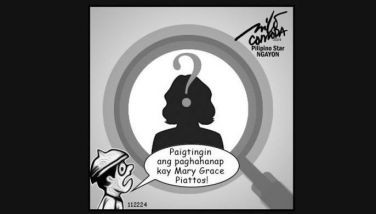The 2004 Nobel science minds
October 14, 2004 | 12:00am
You are sitting on the ground-level veranda of your office glass building, nursing a cup of coffee, escaping from office insanity. You notice everyday things in their "normal" scale: the breadth and width of the chair you are sitting on, the marble floor where your feet rest, the cold, slightly damp table where your elbows are propped, the shiny teaspoon dotted with caffeine, and even the other people sparsely scattered in the veranda. At this scale, you can know where you are by your basic senses – smell, touch, sight, sound and taste. Most of us are just conscious of living in this "floor," in this scale. But what if with each floor below you, things become smaller and with each floor above you, things get bigger, with both directions by a magnitude of 10 (let us say, meters). In this set-up, all floors above you contain you: building, city, archipelago, continent, Earth, Solar System, Milky Way galaxy, local group, cluster, supercluster and the Universe, while all else below you is what you contain: cells, nucleus, DNA, atoms and quarks. (There is a similar exercise called the Powers of 10, a film by Charles and Ray Eames and an accompanying book of the same title written by physicists Philip and Phylis Morrison in 1982.) Now, pretend you can calibrate your senses to observe what happens in any floor. Get on the lift and press floor 10-8. We start here. We have to if we want to try to better understand the works that earned the 2004 Nobel Prizes for Physiology or Medicine, Chemistry and Physics.
Button 10-8 rings and the elevator door opens. You step outside surprised because not only can you smell roses in the air but that you can actually see the shape of molecules that make up the aroma of roses and follow them. This is the world, the scale that Americans Dr. Linda B. Buck of the Fred Hutchinson Cancer Research Center and Dr. Richard Axel of Columbia University "inhabited" and probed and for which they won the 2004 Nobel Prize for Physiology or Medicine. You accompany the rose molecules as they travel to the upper part of the nose of a lady-in-love where about five million olfactory cells rest (just for reference, sheep has 220 million) that house some kind of specialized proteins called odorant receptors – sort of like a special commando of 350 receptors solely for aromas. Each odorant molecule, like the rose’s, could activate more than one receptor and a receptor is able to recognize a number of odorant molecules. These receptors send messages to the olfactory bulb in our brain which, in turn, sends messages to other parts of the brain which form a pattern so that we can recognize the smell (humans can recognize some 10,000 different odors) and further, even make visual, auditory, taste, tactile and even emotional associations with that aromatic souvenir. At the end of the molecular rose path, you then come upon the lady-in-love’s complete memory associated with the sweet, deep scent of the rose. That is what Drs. Buck and Axel drew for us – the identification of olfactory genes which code for the odorant receptors and the molecular path of the scents through our noses to our brains. The experiments that formed this achievement could lead to many other discoveries and applications related to our sense of smell, probably putting to better scientific test the claims that aromas play significant roles in healing body and mind, as well as making better insect-repellant formulas that block the odorant receptors of certain disease-carrying insects. Now, you are more suffused with the rosy aroma and its associated memories than you ever were in your life. Time to move on to the West Wing of this same floor 10-8 where we are still on the level of the cell and the protein molecules that they process to enable creatures like ourselves to travel all these spaces of life.
Here, inside the cell where proteins are being coded, processed, hauled off, recycled, you see "U" signs on a lot of proteins moving around and you wonder if the MMDA has overstepped its bounds. But luckily, "U" here stands for "ubiquitin," a small protein that the Nobel winners for Chemistry, Dr. Aaron Ciechanover, 57, and Dr. Avram Hershko, 67, both Israeli professors of biochemistry at the Technion-Israel Institute of Technology in Haifa, and an American, Dr. Irwin A. Rose, 78, a scientist at the University of California, Irvine discovered was found in all organisms other than bacteria, thus the letter-label. "U" is some sort of "scarlet letter" which the cell "sears" onto the protein it wants destroyed which identifies it to be hauled into the chambers of the cell’s cytoplasm called proteasomes which then slice them to be recycled into new proteins. The destruction of these proteins give the cue for cells to divide. As we all know, it is cell division that keep us alive and it is also uncontrolled cell division that defines cancer. The achievements of these Nobel winners have allowed us to probe an aspect deeper into our own innerspace – into the lives and deaths of our cells, small worlds but worlds unto themselves within us all. Knowing what cues for these little deaths could give us a much deeper understanding of the "big" deaths we all try to postpone.
Now, brace yourselves because to observe the world probed by the Nobel Laureates for Physics, we go eight floors down from the floor of the lives of cells and large molecules. Press button 10-16. Recalibrate before you step out. This is the home of the smallest particle in nature known so far called "quarks" found inside protons and neutrons. You see quarks highly interacting with one another, governed by one of the four fundamental forces of Nature called "strong" nuclear force which is the superglue that binds quarks inside protons and neutrons. But in a flash, you will see what the new Nobel Laureates in Physics, Dr. David J. Gross of the Kavli Institute for Theoretical Physics at the University of California at Santa Barbara, Dr. Frank Wilczek of the Massachusetts Institute of Technology and Dr. H. David Politzer of the California Institute of Technology theorized: At very close distances, quarks inside protons behave like "free" particles, i.e., they do not interact with one another, which was a surprise since following nuclear theories, they should be, and all the more attracted to each other the farther you pull them apart. But it seems that at such closeness, quarks "lose interest" in each other and behave as if no one else were in the room (technical term is "asymptotic freedom"). It seems that at extremely close range, "quarks" like people, also dash for freedom when things get "too close for comfort." The published works of the physicists came out in 1973 and were later verified by experiments by particle accelerators and the results were found to be consistent with their theory.
Those were the innerspaces of life that the Nobel 2004 minds probed. Time for you to get on the lift and decompress. Traveling 16 orders of magnitude down into the smallest of things in an elevator designed by the Powers of Ten might not be your idea of a relaxing coffee break. But it gives you a certain kick that opens the shutters of your mind’s eye in a way that caffeine never could. Going back to the elevator to return to your office, the door opens and the voice asks: "Going up?" You say, "Oh, okay, why not?"
For comments, e-mail: [email protected].
Button 10-8 rings and the elevator door opens. You step outside surprised because not only can you smell roses in the air but that you can actually see the shape of molecules that make up the aroma of roses and follow them. This is the world, the scale that Americans Dr. Linda B. Buck of the Fred Hutchinson Cancer Research Center and Dr. Richard Axel of Columbia University "inhabited" and probed and for which they won the 2004 Nobel Prize for Physiology or Medicine. You accompany the rose molecules as they travel to the upper part of the nose of a lady-in-love where about five million olfactory cells rest (just for reference, sheep has 220 million) that house some kind of specialized proteins called odorant receptors – sort of like a special commando of 350 receptors solely for aromas. Each odorant molecule, like the rose’s, could activate more than one receptor and a receptor is able to recognize a number of odorant molecules. These receptors send messages to the olfactory bulb in our brain which, in turn, sends messages to other parts of the brain which form a pattern so that we can recognize the smell (humans can recognize some 10,000 different odors) and further, even make visual, auditory, taste, tactile and even emotional associations with that aromatic souvenir. At the end of the molecular rose path, you then come upon the lady-in-love’s complete memory associated with the sweet, deep scent of the rose. That is what Drs. Buck and Axel drew for us – the identification of olfactory genes which code for the odorant receptors and the molecular path of the scents through our noses to our brains. The experiments that formed this achievement could lead to many other discoveries and applications related to our sense of smell, probably putting to better scientific test the claims that aromas play significant roles in healing body and mind, as well as making better insect-repellant formulas that block the odorant receptors of certain disease-carrying insects. Now, you are more suffused with the rosy aroma and its associated memories than you ever were in your life. Time to move on to the West Wing of this same floor 10-8 where we are still on the level of the cell and the protein molecules that they process to enable creatures like ourselves to travel all these spaces of life.
Here, inside the cell where proteins are being coded, processed, hauled off, recycled, you see "U" signs on a lot of proteins moving around and you wonder if the MMDA has overstepped its bounds. But luckily, "U" here stands for "ubiquitin," a small protein that the Nobel winners for Chemistry, Dr. Aaron Ciechanover, 57, and Dr. Avram Hershko, 67, both Israeli professors of biochemistry at the Technion-Israel Institute of Technology in Haifa, and an American, Dr. Irwin A. Rose, 78, a scientist at the University of California, Irvine discovered was found in all organisms other than bacteria, thus the letter-label. "U" is some sort of "scarlet letter" which the cell "sears" onto the protein it wants destroyed which identifies it to be hauled into the chambers of the cell’s cytoplasm called proteasomes which then slice them to be recycled into new proteins. The destruction of these proteins give the cue for cells to divide. As we all know, it is cell division that keep us alive and it is also uncontrolled cell division that defines cancer. The achievements of these Nobel winners have allowed us to probe an aspect deeper into our own innerspace – into the lives and deaths of our cells, small worlds but worlds unto themselves within us all. Knowing what cues for these little deaths could give us a much deeper understanding of the "big" deaths we all try to postpone.
Now, brace yourselves because to observe the world probed by the Nobel Laureates for Physics, we go eight floors down from the floor of the lives of cells and large molecules. Press button 10-16. Recalibrate before you step out. This is the home of the smallest particle in nature known so far called "quarks" found inside protons and neutrons. You see quarks highly interacting with one another, governed by one of the four fundamental forces of Nature called "strong" nuclear force which is the superglue that binds quarks inside protons and neutrons. But in a flash, you will see what the new Nobel Laureates in Physics, Dr. David J. Gross of the Kavli Institute for Theoretical Physics at the University of California at Santa Barbara, Dr. Frank Wilczek of the Massachusetts Institute of Technology and Dr. H. David Politzer of the California Institute of Technology theorized: At very close distances, quarks inside protons behave like "free" particles, i.e., they do not interact with one another, which was a surprise since following nuclear theories, they should be, and all the more attracted to each other the farther you pull them apart. But it seems that at such closeness, quarks "lose interest" in each other and behave as if no one else were in the room (technical term is "asymptotic freedom"). It seems that at extremely close range, "quarks" like people, also dash for freedom when things get "too close for comfort." The published works of the physicists came out in 1973 and were later verified by experiments by particle accelerators and the results were found to be consistent with their theory.
Those were the innerspaces of life that the Nobel 2004 minds probed. Time for you to get on the lift and decompress. Traveling 16 orders of magnitude down into the smallest of things in an elevator designed by the Powers of Ten might not be your idea of a relaxing coffee break. But it gives you a certain kick that opens the shutters of your mind’s eye in a way that caffeine never could. Going back to the elevator to return to your office, the door opens and the voice asks: "Going up?" You say, "Oh, okay, why not?"
BrandSpace Articles
<
>
- Latest
Latest
Latest
September 30, 2024 - 8:00am
September 30, 2024 - 8:00am
September 26, 2024 - 2:00pm
September 26, 2024 - 2:00pm
September 3, 2024 - 1:00pm
September 3, 2024 - 1:00pm
Recommended





























